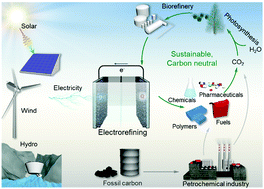Electrocatalytic oxidative upgrading of biomass platform chemicals: from the aspect of reaction mechanism
Abstract
Oxidation reactions provide a wide range of important chemicals in industry; however, most of these chemicals are produced from fossil feedstocks. As a candidate of oxygen evolution reaction (OER), the electrooxidation of biomass platform chemicals instead of a petroleum source offers a sustainable and atom-economic avenue toward organic oxygenates, with additional benefits when coupled with renewable electricity driven processes. This highlight article describes the representative examples in this nascent area, including oxidative dehydrogenation, coupling, and cleavage. We classify the examples into inner-sphere and outer-sphere electrode reactions based on the classical electrocatalysis concept for better understanding of the reaction mechanism. Moreover, we highlight the recent progress in oxidative biomass electrorefining via inner-sphere anodic reactions, which are strongly dependent on the nature of the electrode material. Particularly, the understanding of the formation of reactive oxygen species, adsorption of substrates, and reconstruction of anode materials is presented. Finally, the existing challenges and perspectives are discussed.

- This article is part of the themed collection: Chemical Communications HOT articles


 Please wait while we load your content...
Please wait while we load your content...